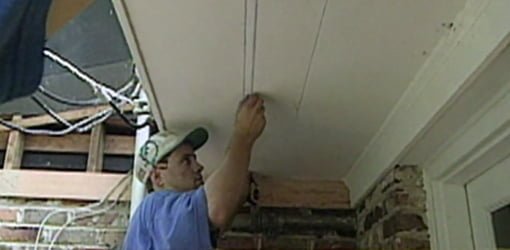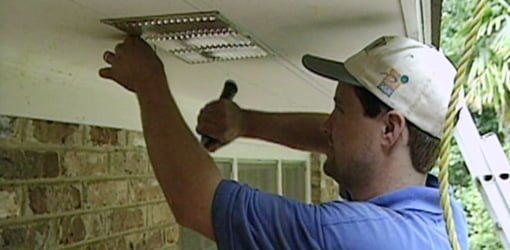Installing A Bathroom Vent Through Soffit
Installing A Bathroom Vent Through Soffit
Attic ventilation reduces heat buildup, which in return cuts cooling costs and prolongs the life of asphalt shingle roofs. If your attic doesn't have proper ventilation, the best way to increase the flow of fresh air through your attic is by adding vents to the soffit boards on the bottom of your eaves.
Soffit eave vents work in conjunction with gable, roof, or ridge vents to provide a natural flow of air through your attic. As the air in the attic heats up, it rises, drawing cool air in the soffit vents at the bottom and exiting through the gable, roof, or ridge vents at the top.
Types of Soffit Vents:
- Rectangular
- Round
- Continuous
- Perforated vinyl or aluminum
Rectangular soffit vents are among the most common and easiest to install. They are available in several sizes, including 4″x16″ and 8″x16″.
Read our article on How to Calculate Attic Vent Space to find out how much venting your attic needs.
Material Needed to Install Soffit Vents:
- Rectangular soffit vents
- Circular saw or saber saw
- Chalk line
- Measuring tape
- Goggles or safety glasses and dust mask
- Nails or screws
- Exterior caulk and caulking gun
- Hammer or Cordless drill/driver
How to Install Rectangular Soffit Vents:
- Layout Vent Width: Pop two parallel chalk lines on the soffit board with the distance between them 1" less than the outside width of the soffit vents.
- Layout Vent Length: Mark the location of the ends of each soffit vent 1" less than the outside length of the vent, making sure each vent falls between the soffit joists or rafters. To locate the joists or rafters, look for the nails attaching the soffit or use a deep sensing stud finder.
- Cut Hole for Vent: Use a circular saw or saber saw to cut the holes in the soffit board for each vent.
- Clear Opening to Attic: Remove the vent cutout, and check to make sure nothing is blocking access to the attic. Move any insulation out of the way that is covering the hole or blocking attic access.
- Apply Caulking: Apply a bead of caulking around the inside of each vent 1/4″ in from the outer perimeter.
- Position Vent: Center each soffit vent over the hole with the vents parallel to the eaves and the vent louvers facing in toward the house.
- Attach Vent: Screw or nail each vent to the soffit board.



Watch this video to find out more.
Further Information
- Attic Ventilation (article)
- How to Calculate Attic Vent Area Needed When Adding Soffit Vents (article)
- Adding Soffit and Ridge Vents to an Attic (video)
- Which Way to Face Eave Soffit Vents (article)
VIDEO TRANSCRIPT
Danny Lipford: Now, when it really starts getting hot outside, homeowners start thinking about how they can keep the interior of their home nice and cool. Now, in some parts of the country that means air conditioning; in other parts simply raising the windows and keeping the ceiling fans going.
But one area that a lot of people just don't think about is keeping their attic cooler. Now, if you keep your attic cooler, the interior of your home is going to be cooler. And your shingles on your roof will last a lot longer, because you're not baking them from the intense heat in your attic. The solution to all of these problems is to provide nice, fresh air into your attic through some type of soffit vent.
Now, this is a very standard one that's eight inches by sixteen inches. They're also available in a round style. Also, a continuous vent that runs all the way around the perimeter of your overhang area. And if you have vinyl on your house, they're available in the perforated type of vinyl vent. Either way they're introducing that fresh air into your attic that'll keep it cooler.
Now this vent is probably the easiest one to install. First, mark off the spaces where the vents will go, being careful to avoid seams in the soffit plywood. Then cut the holes slightly smaller than the vent itself with a circular saw or sabre saw. The vents themselves can be nailed or screwed into place.
Now this new source of air flow will really pay you big dividends this summer, because your power bills will go down and your home will be a lot more comfortable.
Installing A Bathroom Vent Through Soffit
Source: https://todayshomeowner.com/video/how-to-install-soffit-eave-vents-on-your-home/


Tidak ada komentar:
Tulis komentar